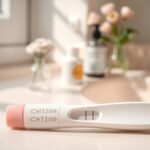Knowing your body’s natural signs of fertility is key when trying to get pregnant or track your cycle. Ovulation, when a mature egg is released, is a vital part of making babies. It shows your most fertile days. By noticing ovulation symptoms, you can learn about your fertility and boost your chances of getting pregnant.
In this detailed guide, we’ll look at the nine main signs of ovulation. This knowledge will help you understand your body’s cycles better. It will also help you make smart choices about your reproductive health.
Key Takeaways
- Ovulation is a crucial part of the menstrual cycle and a key indicator of fertility
- Recognizing common ovulation symptoms can help you track your most fertile days
- Understanding your body’s unique fertility signs can optimize your chances of conception
- Monitoring ovulation symptoms is essential for women trying to conceive or manage their reproductive health
- Paying attention to changes in cervical mucus, basal body temperature, and other physical signs can provide valuable insights into your ovulation cycle
Understanding the Ovulation Cycle and Fertility Window
To understand ovulation, we must explore the hormonal changes that control it. The ovulation cycle is influenced by luteinizing hormone, follicle-stimulating hormone, estrogen, and progesterone.
The Role of Hormones in Ovulation
The cycle begins with follicle-stimulating hormone helping a dominant follicle grow in the ovary. This follicle then releases estrogen. The rise in estrogen prompts the release of luteinizing hormone. This hormone surge causes the egg to be released, starting ovulation.
Timing Your Fertile Days
The fertile window is when a woman is most likely to get pregnant. It lasts about 6 days, from 5 days before ovulation to the day of ovulation. By tracking ovulation, couples can plan the best time for intercourse to increase their chances of pregnancy.
Why Tracking Ovulation Matters
Tracking ovulation is key for those trying to conceive or avoid pregnancy. It helps individuals make smart choices about their reproductive health and family planning.
“Knowing when you ovulate can help you time intercourse to increase your chances of getting pregnant, or avoid pregnancy if that’s your goal.”
Basal Body Temperature Changes During Ovulation
Tracking your basal body temperature (BBT) is a great way to predict ovulation and understand your fertility cycle. BBT is your body’s temperature when you’re resting. It usually goes up a bit after ovulation.
To use BBT charting well, take your temperature every morning before getting up. This makes your baseline consistent. Around ovulation, you’ll see a temperature spike or thermal shift of 0.4-1.0°F (0.2-0.6°C).
By watching these BBT changes closely, you can know when ovulation happens. This helps you guess your most fertile days. It’s useful for those trying to get pregnant or avoid it through ovulation prediction.
| Temperature Before Ovulation | Temperature After Ovulation |
|---|---|
| Slightly lower, around 97-98°F (36.1-36.7°C) | Rises about 0.4-1.0°F (0.2-0.6°C) and stays high for the rest of the cycle |
By tracking your BBT regularly, you can learn a lot about your ovulation cycle and fertility. This knowledge helps you make smart choices about family planning and reproductive health.
Cervical Mucus Changes as a Key Indicator
Tracking ovulation can be done by watching cervical mucus changes. The type and look of your cervical fluid tell a lot about your fertility. It helps you know when you’re most likely to get pregnant.
Types of Cervical Mucus
Your cervical mucus changes a lot during your cycle. At the start, it’s dry or sticky and looks cloudy. As ovulation nears, it turns clear and stretchy, like egg white. This is your most fertile time.
How to Check Cervical Mucus
- Gently insert a clean finger into your vagina and collect a small sample of the mucus.
- Look at the color, texture, and consistency of the mucus. Is it clear and stretchy like raw egg white, or is it thick and sticky?
- Do this check at the same time each day, like when you use the restroom, to keep a routine.
Recording Mucus Changes
Tracking your cervical fluid consistency over time helps spot patterns. Use a fertility app, a menstrual cycle chart, or a notebook to record your findings. This info is crucial for trying to conceive or understanding your body’s cycles.
By watching your cervical mucus closely, you learn more about your ovulation cycle. This key sign, along with others, gives a full picture of your fertility. It helps you plan the best times for conception.
Ovulation Symptoms and Physical Changes
During ovulation, your body changes in ways that can tell you about your fertility. Knowing these ovulation symptoms helps you track your cycle and find your most fertile days.
Mittelschmerz is a common sign of ovulation. It’s a mild pain in the belly that happens in the middle of your cycle. This pain comes from the egg being released from the ovary and can last a few minutes to hours.
Bloating is another symptom that may show up around ovulation. It happens because estrogen levels go up, causing fluid retention and a feeling of fullness in the belly.
- Some women might see light spotting or feel ovulation pain as the egg is released.
- These changes are usually short-lived and can vary from person to person.
Not all women notice these symptoms, and their presence or absence doesn’t mean there’s a problem with ovulation. Paying attention to your body and tracking your cycle can help you understand your unique ovulation patterns.
“Tracking ovulation symptoms can be a powerful tool in understanding your fertility and optimizing your chances of conception.”
Breast Tenderness and Sensitivity
Breast tenderness and sensitivity are common symptoms during ovulation. These changes are linked to hormonal shifts in the menstrual cycle.
Hormonal Impact on Breast Tissue
Estrogen and progesterone levels rise before ovulation. This makes the breast tissue more sensitive and swollen. Increased blood flow and fluid retention cause fullness, soreness, or discomfort.
Duration of Breast Changes
Breast tenderness and sensitivity start a few days before ovulation. They may last several days after. The length of these changes varies among individuals. They can feel similar to premenstrual symptoms during the luteal phase.
| Symptom | Typical Duration |
|---|---|
| Sore breasts | 2-3 days before ovulation, up to 1 week after |
| Increased breast sensitivity | 3-4 days before ovulation, up to 5 days after |
| Hormonal breast changes | Throughout the ovulation cycle, more pronounced around ovulation |
Understanding how hormones affect breast tissue helps women tell ovulation-related tenderness from premenstrual symptoms.
Mild Pelvic Pain and Cramping
As you get closer to ovulation, you might feel mild pelvic pain or cramping. This discomfort comes from the changes in your body during ovulation.
The ovarian pain or one-sided discomfort is usually felt in the lower abdomen, near the ovary releasing the egg. This ovulation cramps feels like a dull, achy sensation. It usually lasts a few minutes to a couple of hours.
The pain’s intensity can vary from person to person. It’s important to remember that this pain is generally milder than menstrual cramps. If the pain is severe or lasts a long time, see your healthcare provider.
To tell if the pain is from ovulation or your period, watch when and where you feel it. Ovulation cramps happen around the middle of your cycle. Menstrual cramps start your period.
| Symptom | Ovulation Cramps | Menstrual Cramps |
|---|---|---|
| Location | Lower abdomen, near the ovary | Lower abdomen, radiating to the back |
| Intensity | Mild to moderate | Moderate to severe |
| Timing | Around ovulation | During menstruation |
Knowing the difference between ovulation pain and menstrual cramps helps you understand your body better. This knowledge is key to managing and tracking your reproductive health.
Changes in Libido and Mood
During ovulation, the body goes through a big hormonal change. This affects a woman’s sex drive and mood. It’s important to know about this, as it helps us understand how hormones, desire, and mood are connected.
Hormonal Influence on Sex Drive
The rise in estrogen and testosterone around ovulation boosts sex drive. These hormones are key in controlling libido. Their peak during the fertile window makes people more intimate. This is thought to be a natural way to encourage mating and conception.
Emotional Fluctuations
Ovulation also brings emotional mood swings and hormonal mood changes. Hormone levels change, leading to more sensitivity, irritability, or even happiness. These feelings can differ a lot from person to person. It’s key to understand and handle them as part of ovulation.
Knowing how hormones affect libido and mood during ovulation helps women deal with these changes. By being aware of these signs, people can make choices that support their emotional and physical health during ovulation.
Additional Physical Signs of Ovulation
Ovulation is a complex process with many hormonal changes. While signs like basal body temperature shifts and cervical mucus changes are well-known, there are more physical signs. These signs can give insight into the body’s ovulation cycle.
Heightened Senses are one such sign. Women often notice a stronger sense of smell during ovulation. This is thought to be due to the rise in estrogen levels before ovulation.
Another sign is Changes in Cervical Position. The cervix softens, opens slightly, and rises higher in the vaginal canal as ovulation approaches. You can check this by gently inserting a clean finger into the vagina. But, this method needs practice and may not work for everyone.
Lastly, some women notice Skin Changes during ovulation. They might see a slight glow or radiance on their skin. This is believed to be caused by increased blood flow and hormonal changes around ovulation time.
While these signs can offer valuable insights, they might not be as reliable as basal body temperature and cervical mucus. Tracking a mix of signs can give a better understanding of the ovulation cycle.
Conclusion
This article has covered the nine key signs of ovulation. These include changes in basal body temperature and cervical mucus. It also talked about physical sensations and mood shifts.
By knowing these signs, women can track their fertility cycles better. This helps them plan for conceiving or natural family planning.
Using different ovulation tracking methods is key. For example, tracking basal body temperature and cervical fluid changes. This gives a clearer picture of the fertile window.
This knowledge helps people make smart choices about their reproductive health. It’s important for planning families.
It’s crucial to talk to healthcare professionals for personal advice. They can guide on ovulation tracking, fertility awareness, and natural family planning. Working with medical experts ensures the best use of ovulation tracking methods for individual needs.
FAQ
What are the key signs of ovulation?
The main signs of ovulation include changes in basal body temperature and cervical mucus. You might also feel ovulation pain, breast tenderness, and mood swings. Other signs are changes in libido, heightened senses, and cervical position changes.
How do hormones influence the ovulation cycle?
Hormones like luteinizing hormone and follicle-stimulating hormone are key. Estrogen and progesterone also play important roles. They help regulate the ovulation cycle and determine when you’re most fertile.
Why is tracking ovulation important?
Tracking ovulation is crucial for getting pregnant or avoiding it. It helps find the best days to conceive or use contraception.
How can basal body temperature be used to predict ovulation?
Basal body temperature usually goes up by 0.4-1.0°F after ovulation. This change helps predict when you’re most fertile.
What changes in cervical mucus indicate ovulation?
Cervical mucus becomes wet, clear, and stretchy (like raw egg whites) before ovulation. This is a key sign of fertility.
What are some physical symptoms associated with ovulation?
Symptoms of ovulation include mild abdominal pain, bloating, and light spotting. You might also feel breast tenderness and an increased libido.
How do mood and libido changes relate to ovulation?
Hormonal changes during ovulation can boost your sex drive. You might also experience mood swings or heightened sensitivity.
What other physical signs can indicate ovulation?
Other signs of ovulation include a stronger sense of smell and changes in cervical position. You might also notice skin changes.
How can multiple ovulation tracking methods be combined?
For the most accurate prediction, use several methods. Basal body temperature, cervical mucus monitoring, and ovulation tests or apps are recommended.







